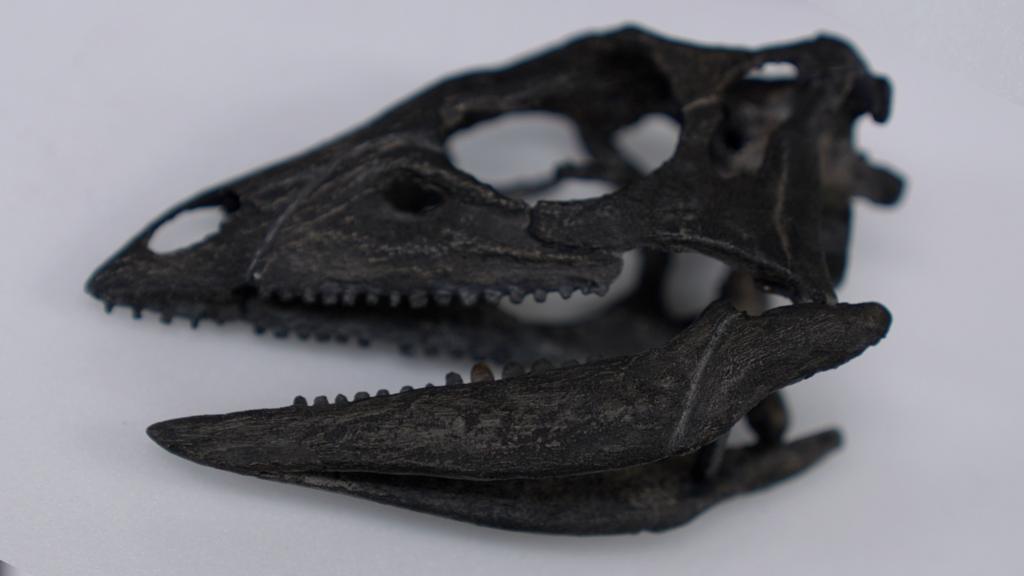Scientists have reclassified a dinosaur, previously miscategorized upon its discovery, as a new species roughly the size of a Labrador retriever.
Named Enigmacursor, meaning “puzzling runner,” this dinosaur roamed the Earth approximately 150 million years ago, coexisting with well-known giants like the Stegosaurus.
Initially identified as a Nanosaurus, researchers now assert its distinct identity.
On Thursday, Enigmacursor will become the first new dinosaur exhibit to be unveiled at London’s Natural History Museum (NHM) since 2014.
BBC News gained exclusive access to the dinosaur before its public debut.
According to Professor Paul Barrett, a palaeontologist at the museum, the discovery promises to illuminate the evolutionary journey that transformed early small dinosaurs into large and “bizarre” creatures.
During a behind-the-scenes visit, the designer of Enigmacursor’s custom glass display case was observed making final adjustments.
The dinosaur’s new location is a balcony within the museum’s Earth Hall, situated above Sophie the Stegosaurus, another resident of the Morrison Formation in the Western United States.
Enigmacursor is considerably smaller, standing at 64 cm tall and 180 cm long, approximately the size of a Labrador, but with larger feet and a tail “probably longer than the rest of the dinosaur,” according to Professor Susannah Maidment.
“It also had a relatively small head, so it was probably not the brightest,” she added, suggesting it was likely a juvenile at the time of its death.
With the fossilized remains of its bones, conservators Lu Allington-Jones and Kieran Miles meticulously assembled the skeleton onto a metal frame.
“I don’t want to damage it at this stage before its revealed to everybody,” says Ms Allington-Jones, head of conservation.
“Here you can see the solid dense hips showing you it was a fast-running dinosaur. But the front arms are much smaller and off the ground – perhaps it used them to shovel plants in its mouth with hands,” says Mr Miles.
Clues within the bones led NHM scientists to the conclusion that the creature was a new species.
“When we’re trying to identify if something is a new species, we’re looking for small differences with all of the other closely-related dinosaurs. The leg bones are really important in this one,” says Prof Maidment, holding the right hind limb of the Enigmacursor.
Upon its donation to the museum, the dinosaur was classified as Nanosaurus, consistent with the naming conventions for many small dinosaurs since the 1870s.
However, the scientists suspected that categorisation was false.
To find out more, they travelled to the United States with scans of the skeleton and detailed photographs to see the original Nanosaurus that is considered the archtype specimen.
“But it didn’t have any bones. It’s just a rock with some impressions of bone in it. It could be any number of dinosaurs,” Professor Maidment said.
In contrast, the NHM’s specimen was a sophisticated and near-to-complete skeleton with unique features including its leg bones.
Untangling this mystery around the names and categorisation is essential, the palaeontologists say.
“It’s absolutely foundational to our work to understand how many species we actually have. If we’ve got that wrong, everything else falls apart,” says Prof Maidment.
The scientists have now formally erased the whole category of Nanosaurus.
They believe that other small dinosaur specimens from this period are probably also distinct species.
The discovery should help the scientists understand the diversity of dinosaurs in the Late Jurassic period.
Smaller dinosaurs are “very close to the origins of the large groups of dinosaurs that become much more prominent later on,” says Prof Barrett.
“Specimens like this help fill in some of those gaps in our knowledge, showing us how those changes occur gradually over time,” he adds.
Looking at these early creatures helps them identify “the pressures that finally led to the evolution of their more bizarre, gigantic descendants,” says Prof Barrett.
The scientists are excited to have such a rare complete skeleton of a small dinosaur.
Traditionally, big dinosaur bones have been the biggest prize, so there has been less interest in digging out smaller fossils.
“When you’re looking for those very big dinosaurs, sometimes it’s easy to overlook the smaller ones living alongside them. But now I hope people will keep their eyes close to the ground looking for these little ones,” says Prof Barrett.
The findings about Enigmacursor mollyborthwickae are published in the journal Royal Society Open Science.
The telescope should detect killer asteroids and may even find the ninth planet in our solar system.
Destroying Iran’s stores of enriched uranium would bring danger for people nearby but not trigger another Chernobyl.
Thousands of fragments of plaster are pieced together to reveal frescos from a Roman London villa.
Climate change will benefit basking sharks in the UK but creatures like the longest living animal may struggle.
Never before seen pictures will help scientists learn how the Sun’s activity changes from stormy to quiet periods

